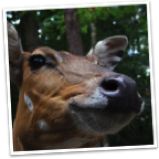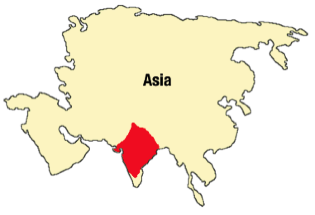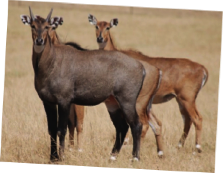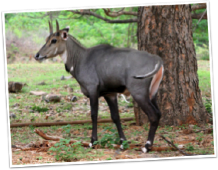
Nilgai meat is considered a delicacy, including in the United States. It is said that the meat of a nilgai resembles beef, but with lower fat and less flavor. They have a lean but tender meat that has a mild flavor without the wild gamey flavor of other game meats. Fine restaurants market and use the Texas antelope because when
The name nilgai comes from the Indian words nil which means blue, and gai which means “cow”. An adult nilgai stands about 5 feet tall at the top of the shoulder and weighs up to 600 pounds. Unlike other antelope, the male and female nilgai look physically different at adulthood. This is called sexual dimorphism. When fully mature, a nilgai bull will be a smokey charcoal color with black and white markings on their throat, mane, and legs. They also have small straight horns measuring around 7 inches. Nilgai cows do not usually grow horns, and remain a light brown color with the same black and white markings throughout their life.
Nilgais are a herd animal, usually living in small groups of about 10 animals. However, it is not uncommon for them to gather in groups of up to 70 animals. Throughout the year the males and females do not stay together. Rather they form fluid herds, changing herds often for mating. A nilgai cow will give birth once a year and will commonly deliver either a single calf or twins.
Nilgais both browse and graze for grasses, shrubs, and berries. They prefer dry open areas, avoiding dense woods, but may also be found in shrub forests, cultivated farmland, and even marshes. Nilgais are often a nuisance to local farmers because they destroy the crops. Even so, in areas where they are considered sacred they are not hunted.
In the 1920s, a ranch in south Texas brought nilgais to the United States for recreational purposes. They were very well suited to the climate and vegetation in the area, and the nilgais flourished. Some nilgais managed to escape, and Texas Parks and Wildlife Department estimated that there are over 1,000 feral nilgais roaming south Texas and northern Mexico. Because of their feral status in the United States, nilgais are often called Texas Antelope.


Fast Facts





Name: Miniature Zebu
Scientific: Bos indicus
Family: Bovidae
Relatives: Indu-Brazil Zebu, Brahman,
Nelore, Ongole
Environment: Sub-Tropic, Plains
Origin: Asia
Life-span: 25 years
Size: 600 lbs
Nilgai antelope are the largest Asian antelope, and are native to India and Pakistan. They are commonly seen throughout India, often on farmland and lightly wooded shrub forests.
Nilgai avoid densely wooded areas, preferring dry open lands. They both graze and forage for a variety of plants and grasses based on availability.
1. There are over 1,000 feral nilgai in
South Texas and Mexico.
2. Nilgai are also known as blue bulls.
3. In the 1920s, nilgai were brought to the US.

Nilgai antelope are a member of the bovine family. Hindu people considered them to be sacred.
About Me
Snapshot
Exploration
Uses




compared with beef, chicken, and even lamb, antelope meat has fewer calories per serving, and is lower in saturated fat.


